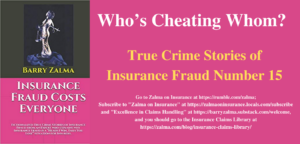Who’s Cheating Whom? Insurance Fraud Hurts Fraudster

See the full video at https://rumble.com/vuei6q-whos-cheating-whom-insurance-fraud-hurts-fraudster.html?mref=6zof&mrefc=2 and at https://youtu.be/batUshpci-U
 Barry Zalma, Esq., CFE presents videos so you can learn how insurance fraud is perpetrated and what is necessary to deter or defeat insurance fraud. This Video Blog of True Crime Stories of Insurance Fraud with the names and places changed to protect the guilty are all based upon investigations conducted by me and fictionalized to create a learning environment for claims personnel, SIU investigators, insurers, police, and lawyers better understand insurance fraud and weapons that can be used to deter or defeat a fraudulent insurance claim.
Barry Zalma, Esq., CFE presents videos so you can learn how insurance fraud is perpetrated and what is necessary to deter or defeat insurance fraud. This Video Blog of True Crime Stories of Insurance Fraud with the names and places changed to protect the guilty are all based upon investigations conducted by me and fictionalized to create a learning environment for claims personnel, SIU investigators, insurers, police, and lawyers better understand insurance fraud and weapons that can be used to deter or defeat a fraudulent insurance claim.
Monkey Business Costs Claimant
Some people are too smart for their own good. They want to commit a fraud but don’t know how. In so doing they hurt themselves rather than profit.
When I was a young insurance adjuster, in 1972, the company I worked for as an adjuster waiting to hear from the California Bar about the results of the Bar Exam, my employer insured a homeowner who owned a Capuchin monkey as a pet. The monkey was a friendly sort. He did not like confinement to the house. He wanted to be out and about meeting and greeting the world.
One day, when the insured was not looking, the monkey escaped her home. He was a pet and did not want to run away. He just wanted out of the house. His escape, therefore, led him to the roof of the next-door -neighbor’s house.
The claimant, who for an injury of her type, could have easily talked me into paying her $1,000 to $3,000 back in 1972, thought she had cheated me by changing a $10.00 doctor bill to $100.00 bill. In so doing she gained $90.00 by cheating and lost the opportunity for more than ten to twenty times the fraud by simply being honest.
Her fraud was a success. The insurer did nothing. It reported the fraud to no one. The insured owed the claimant much more than the $106.00 we paid her. The claimant probably thought she committed a brilliant fraud. This time the person actually damaged by the fraud was the claimant, not the insurance company.
Adjusters must always keep in mind that when they receive an offer to settle a claim for an amount that seems too good to be true there is a very high probability that it is, in fact, too good to be true.

© 2022 – Barry Zalma
Barry Zalma, Esq., CFE, now limits his practice to service as an insurance consultant specializing in insurance coverage, insurance claims handling, insurance bad faith and insurance fraud almost equally for insurers and policyholders.
He practiced law in California for more than 44 years as an insurance coverage and claims handling lawyer and more than 54 years in the insurance business.
Subscribe to “Zalma on Insurance” at https://zalmaoninsurance.locals.com/subscribe and “Excellence in Claims Handling” at https://barryzalma.substack.com/welcome.
You can contact Mr. Zalma at https://www.zalma.com, https://www.claimschool.com, zalma@claimschool.com and zalma@zalma.com . Mr. Zalma is the first recipient of the first annual Claims Magazine/ACE Legend Award.
You may find interesting the podcast “Zalma On Insurance” at https://anchor.fm/barry-zalma; you can follow Mr. Zalma on Twitter at; you should see Barry Zalma’s videos on https://www.youtube.com/channel/UCysiZklEtxZsSF9DfC0Expg/featured; or videos on https://rumble.com/zalma. Go to the Insurance Claims Library – https://zalma.com/blog/insurance-claims–library/ The last two issues of ZIFL are available at https://zalma.com/zalmas-insurance-fraud-letter-2/
Like this:
Loading…







